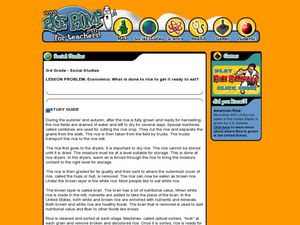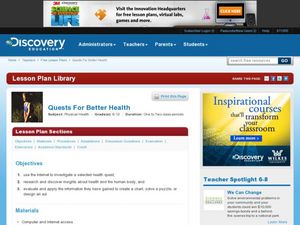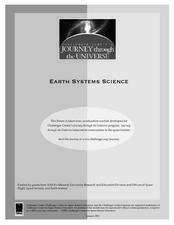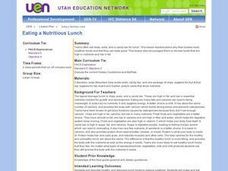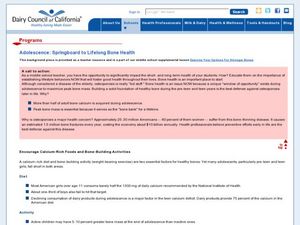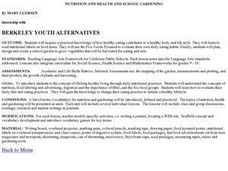Curated OER
Economics: What is done to rice to get it ready to eat?
Third graders create a map showing the journey of rice from the field to the grocery store. For this agriculture lesson, 3rd graders discover and map the process of harvesting and preparing rice to be packaged and shipped to sell to...
Curated OER
Health Issues Related to Space Experiments
Students participate in a science instructional activity that integrates connections between health issues on Earth and how those issues are related to studies conducted on the International Space Station. T
Curated OER
Who's Hungry?
Young scholars research the importance of a healthy diet and the world's nutrition. In this health and diet lesson, students discuss the foods animals and people eat. Young scholars discuss the food chain and create a food chain....
Curated OER
Critics of Cuisine
Young scholars role play the role of food critics. Using recipes, they make nutritious meals at home following specific directions. They write reviews of their recipes and the products they used to make them. They share their review...
Curated OER
Eating a Nutritious Lunch
Students identify the types of foods and snacks they eat for their lunch. In groups, they identify healthy foods along with unhealthy foods. They design a new lunch menu using only healthy food and identifying which food group they belong.
Curated OER
Labelling
Students assess the difference between "use by" and "best before" date markings on food items bought at a grocery store or some other establishment. They determine whether or not stored food is safe to eat and practice developing...
Curated OER
Healthy Living
Students awareness is raised about the importance of dies and how to make simple choices to improve your health and well being. They reflect on things they eat, what they watch on TV, what they say to others, have a group song, and a...
Curated OER
Our Healthy Bodies
Students complete a variety of activities designed to enhance their awareness of their bodies. They examine pictures of themselves, taken at various points in the year and examine and compare their bodies. They enjoy a healthy snack...
Curated OER
Staying Healthy Year Round
Young scholars will read literature about the seasons and observe and describe the weather in each. The group will compare and contrast the activities of people during different weather conditions showing how they adapt to changes. They...
Curated OER
They Don't Just Eat Grass
Middle schoolers explore and examine different types of feed used for livestock. They discuss types of feed, the need for energy and health, and create graphs of food compared to categories. Students organize data and complete worksheets...
Curated OER
Quests for Better Health
Students use the Internet to investigate a health quest that is assigned to them. In this investigative lesson students research insights about the human body, evaluate and apply the information to create a chart, puzzle or design an ad.
Curated OER
Earth Systems Science
Students perform experiments designed to grow plants and bacteria in a controlled environment. For this ecosystems lesson students investigate varying conditions for growing plants and bacteria.
Curated OER
Why Are People Hungry?
Students examine the reasons why people throughout the world are suffering from malnutrition. In groups, they research the origins of various foods and how they are processed before they arrive at the store for us to purchase. They...
Curated OER
Why are People Hungry and Malnourished?
Young scholars read "The Story of Miguel's Tomatoes" to review the steps involved in the food system. In groups, students complete a food system chart. Using the chart as a model, young scholars choose a commonly eaten food and trace it...
Curated OER
Counting on Good Health
First graders engage in fun activities in order to understand the food pyramid and how to make healthy nutritional choices. The lesson is used in order to help students make healthy lifestyle choices.
Curated OER
Eating a Low-fat Nutritious Lunch
Students describe healthy and delicious lunch foods to replace junk foods. They make and eat lunch foods.
Curated OER
Adolescence: Springboard to Lifelong Bone Health
Students discuss bone health. In this health lesson, students talk about foods and activities that can foster strong bones. Students explore ways to defeat obstacles to bone health.
Curated OER
Vegetable Twister
Learners review vegetables and their nutrient values and production. In this vegetable production worksheet, students read information about the nutrients in vegetables and how they are grown. Learners participate in a game of Twister to...
Curated OER
Eating, A Family Affair
Students explain the benefits of eating together as a family. In this adult health lesson, students share their happy mealtime experience with each other. They develop a mealtime goal for their family.
Curated OER
Ocean Pollution
Students study their role in eliminating ocean pollution and helping keep the oceans clean. In this environmental issues lesson, students define pollution and brainstorm examples of ocean pollution. Students define biodegradable and...
Curated OER
Nutrition and Health and School Gardening
Students examine how healthy eating contributes to a healthy body and life style. They read nutritional labels on food items. They use the Five Foods Pyramid to evaluate their own eating habits. They plan, design, and create a school...
Curated OER
You Are What You Eat
Students evaluate their eating habits, focusing on the ways in which one assesses whether or not his or her diet is nutritious. They work in small groups to design a menu for a healthy lunch and write a paragraph justifying their choices.
Curated OER
Health and Growth
Students recognize that living things need food and water. In this health and growth lesson, students identify foods that are better for health and growth. Students sing a song and complete a worksheet. Students understand that they...
Curated OER
Nutrition Track
Students examine the importance of a healthy diet based on the USDA food pyramid. They log their daily food intake in a journal. They create charts to analyze and compare their diets to the USDA recommended allowances.


